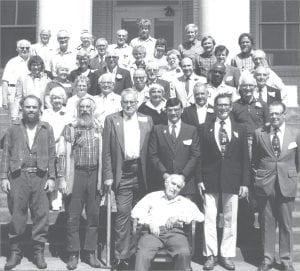Cook County used to be part of Lake County, and when it became a county, it was named after a major in the Civil War— who never stepped foot in Cook County.
In March 2013, a group of history buffs met at the Arrowhead Center for the Arts to share tales about Cook County history. Former county commissioner Chet Lindskog was one of them, and he talked about the wave of European immigrants that expanded the population in the late 1880s and early 1900s, many of them fishermen and loggers. Farmers cleared land throughout the county, piling rocks that can still be seen in places. Workers in the CCC camps built roads, planted trees, and married local girls. Most people here were not hurt too badly by the Depression, he said.
One thing that makes Cook County unique is that it has the lowest point in Minnesota – Lake Superior—and the highest point—Eagle Mountain. Lindskog said that many years ago, he told Governor Rudy Perpich, “If there was no Cook County, there’d be no point to Minnesota!”
The first Cook County board of commissioners meeting was held in 1882. This photo of county employees, commissioners, and officials was taken in 1982 upon the 100th anniversary of the first commissioner meeting. In the photo are many well-known current and past residents including (in rough order from the front) Horace Stickney, John Patten, Leonard Sobanja, Howard Massie, Chet Lindskog, Frank Hansen, Jim Thompson, Jane Furlong, Ethel Jacobson, Lloyd K. Johnson, Ray From, Justine Kerfoot, Sid Backlund Sr., Ken Olsen, Carol Eckel, Lou Goodell, Carol Gresczyk, Carl Noyes, Ann Eliasen, Sherman Benson, Sarah Allard, Dick Horen, John Lyght, Albert Malner, John Hendricks, Harry Popham, Jerry Eisler, Almeda Stickney, Alfred Rindahl, Harry Flaherty, Tim Kennedy, Rosemary Lamson, Steve Lackore, Dick Swanson, Bob O’Conner, Tom Hustvet and Leo Tschida .



Leave a Reply